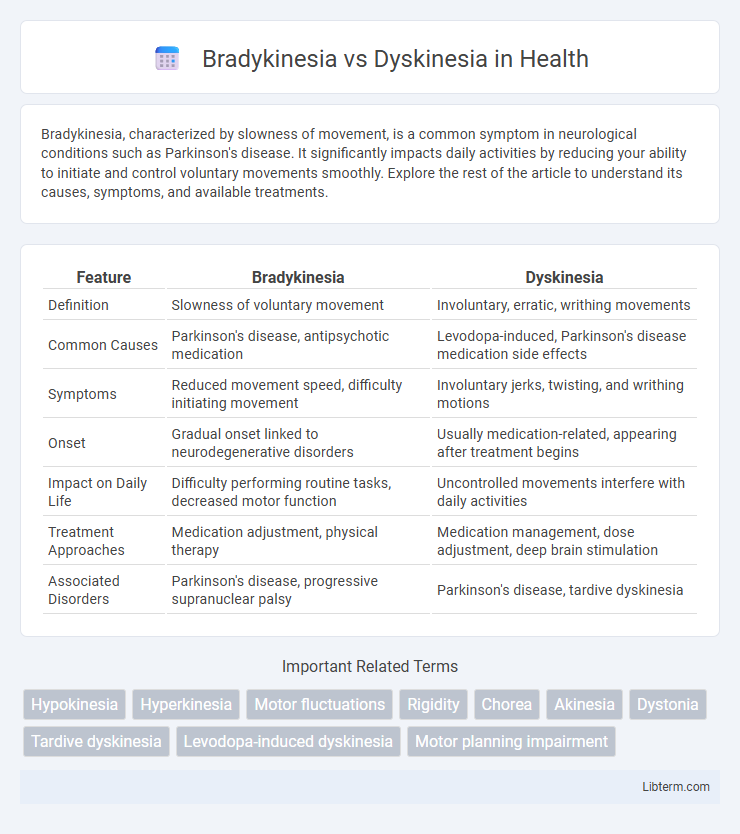Bradykinesia, characterized by slowness of movement, is a common symptom in neurological conditions such as Parkinson's disease. It significantly impacts daily activities by reducing your ability to initiate and control voluntary movements smoothly. Explore the rest of the article to understand its causes, symptoms, and available treatments.
Table of Comparison
| Feature | Bradykinesia | Dyskinesia |
|---|---|---|
| Definition | Slowness of voluntary movement | Involuntary, erratic, writhing movements |
| Common Causes | Parkinson's disease, antipsychotic medication | Levodopa-induced, Parkinson's disease medication side effects |
| Symptoms | Reduced movement speed, difficulty initiating movement | Involuntary jerks, twisting, and writhing motions |
| Onset | Gradual onset linked to neurodegenerative disorders | Usually medication-related, appearing after treatment begins |
| Impact on Daily Life | Difficulty performing routine tasks, decreased motor function | Uncontrolled movements interfere with daily activities |
| Treatment Approaches | Medication adjustment, physical therapy | Medication management, dose adjustment, deep brain stimulation |
| Associated Disorders | Parkinson's disease, progressive supranuclear palsy | Parkinson's disease, tardive dyskinesia |
Introduction to Bradykinesia and Dyskinesia
Bradykinesia refers to the slowness of movement and is a core symptom of Parkinson's disease, characterized by decreased motor speed and difficulty initiating voluntary actions. Dyskinesia involves involuntary, erratic, and often excessive movements, typically resulting from long-term use of dopaminergic medications like levodopa. Differentiating between bradykinesia and dyskinesia is crucial for optimizing Parkinson's treatment strategies and improving patient quality of life.
Defining Bradykinesia: Symptoms and Causes
Bradykinesia, characterized by slowness of movement and reduced amplitude, is a core symptom of Parkinson's disease and other neurodegenerative disorders. It results from dopamine deficiency in the basal ganglia, impairing motor control and causing difficulty in initiating and executing voluntary movements. Common symptoms include decreased facial expression, slow walking, and challenges with fine motor skills such as buttoning shirts or writing.
Understanding Dyskinesia: Types and Manifestations
Dyskinesia refers to involuntary, erratic, and often writhing movements, commonly associated with long-term use of dopaminergic medications in Parkinson's disease, contrasting with bradykinesia, which is characterized by slowness of movement. Types of dyskinesia include peak-dose dyskinesia, occurring at the height of medication effectiveness, diphasic dyskinesia, appearing at the beginning and end of a medication dose, and off-period dystonia, manifesting during medication valleys. These manifestations significantly impact motor control and quality of life, requiring tailored treatment strategies to balance symptom management and side effects.
Key Differences Between Bradykinesia and Dyskinesia
Bradykinesia is characterized by slowness of movement and reduced amplitude in voluntary motions, commonly observed in Parkinson's disease patients. Dyskinesia involves involuntary, erratic, and often excessive movements, typically as a side effect of long-term levodopa therapy. The key differences lie in bradykinesia causing hypokinetic symptoms with decreased motor activity, while dyskinesia results in hyperkinetic symptoms with abnormal excessive movements.
Neurological Disorders Associated with Bradykinesia
Bradykinesia is primarily associated with Parkinson's disease and other parkinsonian syndromes, characterized by the slowness of movement and difficulty initiating voluntary actions. Unlike dyskinesia, which involves involuntary, erratic movements often caused by long-term use of levodopa in Parkinson's treatment, bradykinesia reflects impaired motor control due to basal ganglia dysfunction. Neurological disorders such as progressive supranuclear palsy and multiple system atrophy also present with bradykinesia, highlighting its relevance in diagnosing movement disorders.
Conditions Commonly Linked to Dyskinesia
Dyskinesia is commonly linked to Parkinson's disease, often as a side effect of long-term levodopa therapy causing involuntary, erratic movements. Huntington's disease also features dyskinesia, characterized by rapid, jerky motions due to neurodegeneration in the basal ganglia. Oppositely, bradykinesia primarily occurs in Parkinson's disease, signifying slowness of movement without the involuntary movements seen in dyskinesia.
Diagnostic Approaches for Bradykinesia vs Dyskinesia
Diagnostic approaches for bradykinesia primarily involve clinical assessment using the Unified Parkinson's Disease Rating Scale (UPDRS) to evaluate movement slowness, rigidity, and impaired initiation. Dyskinesia diagnosis often relies on patient history and observation of involuntary, erratic movements, frequently linked to long-term dopaminergic therapy, corroborated by video recordings during motor fluctuations. Advanced techniques like wearable sensors and motion capture systems aid in quantifying movement irregularities for precise differentiation between bradykinesia and dyskinesia.
Treatment Strategies: Managing Bradykinesia
Treatment strategies for managing bradykinesia primarily involve optimizing dopaminergic therapies such as levodopa and dopamine agonists to improve motor function in Parkinson's disease patients. Physical therapy and regular exercise are critical for enhancing movement speed, muscle strength, and coordination. Emerging approaches include deep brain stimulation (DBS), which targets specific brain regions to reduce bradykinesia symptoms effectively.
Therapeutic Options for Dyskinesia
Dyskinesia, characterized by involuntary, erratic movements often induced by long-term use of levodopa in Parkinson's disease, can be managed through several therapeutic options. Adjusting levodopa dosage and incorporating dopamine agonists or MAO-B inhibitors helps reduce symptoms, while advanced treatments like amantadine provide effective relief from dyskinesia. In more severe cases, deep brain stimulation (DBS) targeting the subthalamic nucleus or globus pallidus interna offers significant improvement by modulating aberrant motor signals.
Prognosis and Quality of Life Considerations
Bradykinesia, characterized by slowed movement, often leads to progressive motor impairment that can significantly reduce independence and daily functioning over time. Dyskinesia, which manifests as involuntary, erratic movements typically resulting from long-term levodopa treatment in Parkinson's disease, may cause discomfort and social embarrassment, impacting psychological well-being. Effective management of both conditions through tailored medication regimens and physical therapy is crucial to improving prognosis and maintaining quality of life for affected individuals.
Bradykinesia Infographic

 libterm.com
libterm.com